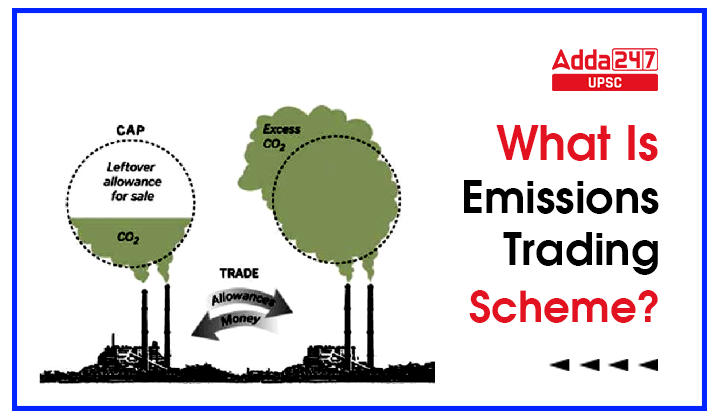Table of Contents
What Is Emissions Trading Scheme(ETS)?
In This Article, ”What Is Emissions Trading Scheme(ETS)?”, We Will Read About The Context Of ETS, What Is Emissions Trading Scheme (ETS)?, Why India Need An ETS?, What Is Existing Perform, Achieve, Trade Scheme In India?, Key Points About ETS, How ETS Is Different From Carbon Credits?, etc.
Context Of Emissions Trading Scheme(ETS)
In News?
- The Centre is in the final stages of notifying an Emissions Trading Scheme (ETS) that would require polluting industries to achieve certain standards of energy efficiency and permit them to ‘trade’ these improvements.
Background
- The Energy (Conservation) Amendment Bill, passed in Parliament in December last year, paved the way for the establishment of a domestic carbon market in India, which seeks to incentivise emissions reductions among carbon-intensive industries.
Why Joshimath In Uttarakhand Is Declared Landslide Subsidence Zone?
What Is Emissions Trading Scheme (ETS)?
- The Emissions Trading Scheme (ETS) is a regulatory tool that is aimed at reducing the pollution load in an area and at the same time minimising the cost of compliance for the industry.
- ETS is a market in which the traded commodity is particulate matter emissions.
- It is also being described as the world’s first market for trading in particulate matter emissions.
- Emissions trading schemes, as they are called, are successfully deployed in the European Union and Korea.
What Is National Clean Air Campaign(NCAP) Tracker?
What Is Existing Perform, Achieve, Trade Scheme In India?
- Since 2015, the BEE has been running the ‘Perform, Achieve, Trade’ scheme under which 1,078 industries spanning 13 sectors have been getting energy security certificates if they exceeded certain targets.
- While similar in principle, the credits generated under the forthcoming mechanism would force companies to invest substantially more in deploying alternate, cleaner sources of energy to meet efficiency norms, as they would likely have to meet a higher bar for emission reductions.
What Is Green Deal Industrial Plan Proposed By EU?
Key Points About Forthcoming Emissions Trading Scheme(ETS) In India
- Coordinator? The Bureau of Energy Efficiency (BEE), a Power Ministry body, would be the nodal coordinator of the Emissions Trading Scheme(ETS) In India.
- Which Sectors Will Be Covered? Sectors (for example, aluminium, cement, fertilizer) would be given energy efficiency targets and the companies that were able to exceed these targets would get ‘credits’ or certificates that they could bank or sell to companies that failed to meet the targets.
- How Will ETS In India Be Different From Other Countries?
- One significant difference in the Indian emissions trading scheme from the ones in Europe or other countries is that companies wouldn’t be required to cut carbon emissions in absolute terms.
- The EU is required to cut emissions under the provisions of the United Nations Framework Convention on Climate Change. India doesn’t have an obligation.
- However, we have committed to reducing the emissions intensity (emissions per unit of GDP) of our GDP by 45% (of 2005 levels) by 2030.
- So it’s possible for companies (under the Indian emissions trading scheme) when they increase production to emit more carbon and still be more efficient.
What is COP 15 of Convention on Biodiversity(CBD)?
Why India Need An ETS?
- India has committed to installing facilities to generate nearly 500 GW of electricity from non-fossil sources by 2030 and this will cost at least ₹2.4 trillion according to an estimate from the Central Electricity Authority.
- India has also pledged to achieve net-zero emissions by 2070, as well as reduce its carbon emissions intensity of gross domestic product (GDP) by 45 per cent by 2030.
- That’s why Carbon markets are viewed as an essential tool by policymakers to achieve these climate goals.
- So, India should have its own emissions trading scheme structure and while we can certainly learn from models in the West, we should ensure that what we do accommodates for our specific needs.
National Mission on Strategic Knowledge for Climate Change (NMSKCC)
How ETS Is Different From Carbon Credits?
- As a precursor to the Indian carbon markets, the Environment Ministry on February 17 listed a range of activities, called greenhouse gas mitigation activities, that would be eligible for trading carbon credits. These include solar thermal power, offshore wind, green hydrogen, compressed biogas and stored renewable energy.
- An emissions trading market is different from traditional “carbon credits”, an older scheme, whereby Indian industries installed systems to generate power from renewable energy sources instead of coal, oil and gas and claimed credits that reflected the emissions that were notionally prevented.
- These credits were sold to exchanges in the European Union where companies were required to offset their emissions with such credits.
- Many companies undertake voluntary offsets to reflect their embrace of clean technology and bank, as well as trade them.
- Carbon credits, in theory, reflect actual prevented emissions and energy certificates from ETS-like schemes reflect investments by industry in complying with government regulations on curbing emissions.
Kunming-Montreal Global Biodiversity Framework (GBF): Landmark Pact at COP 15 of CBD



 TSPSC Group 1 Question Paper 2024, Downl...
TSPSC Group 1 Question Paper 2024, Downl...
 TSPSC Group 1 Answer key 2024 Out, Downl...
TSPSC Group 1 Answer key 2024 Out, Downl...
 UPSC Prelims 2024 Question Paper, Downlo...
UPSC Prelims 2024 Question Paper, Downlo...




